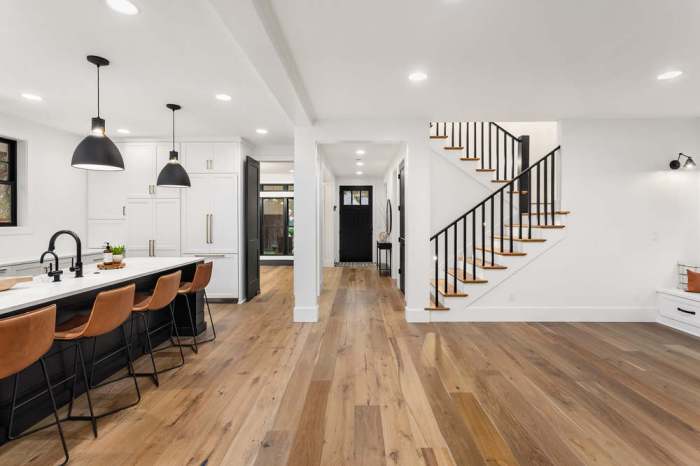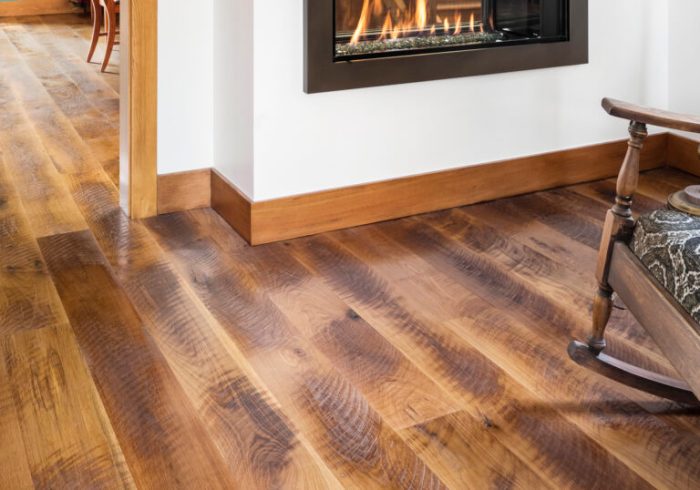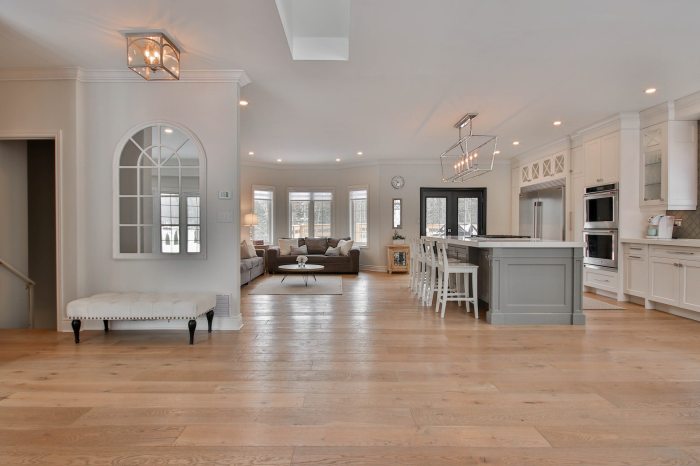The Best Flooring for Home Remodel: A Comprehensive Guide
Embark on a journey to discover the ideal flooring options for your home remodel. From hardwood to laminate, vinyl to tile, this guide explores the pros, cons, and maintenance requirements of each type, helping you make the best choice for your space.
Types of Flooring
When it comes to choosing the right flooring for your home remodel, there are several options to consider. Each type of flooring has its own set of pros and cons, so it's important to weigh them carefully before making a decision.
Hardwood Flooring
Hardwood flooring is a classic choice that adds warmth and elegance to any space. It is durable and can last for decades with proper care. However, hardwood floors can be expensive to install and are susceptible to scratches and water damage.
Laminate Flooring
Laminate flooring is a cost-effective alternative to hardwood that mimics the look of natural wood. It is easy to install and maintain, making it a popular choice for homeowners on a budget. However, laminate flooring is not as durable as hardwood and can be easily damaged by water.
Vinyl Flooring
Vinyl flooring is a versatile option that comes in a wide range of styles and colors. It is durable, water-resistant, and easy to clean, making it ideal for high-traffic areas like kitchens and bathrooms. However, vinyl flooring can be prone to scratches and may not add as much value to your home as hardwood or tile.
Tile Flooring
Tile flooring is a durable and low-maintenance option that is perfect for areas prone to moisture, such as bathrooms and kitchens. It comes in a variety of materials, including ceramic, porcelain, and natural stone. However, tile flooring can be cold and hard underfoot, and the grout lines can be difficult to keep clean.
Considerations for Choosing Flooring

When it comes to choosing the right flooring for your home, there are several important factors to consider. From matching flooring types with different rooms to considering factors like room usage, traffic, and moisture levels, here are some key considerations to keep in mind:
Matching Flooring Types with Different Rooms
- For high-traffic areas like the living room or kitchen, durable flooring options like hardwood, laminate, or tile are ideal.
- In bedrooms or areas where comfort is key, carpet or softer flooring materials may be more suitable.
- In bathrooms or areas with high moisture levels, waterproof flooring options like vinyl or tile are recommended.
Importance of Considering Factors like Room Usage, Traffic, and Moisture Levels
- Room Usage: Consider how each room will be used to determine the best flooring option. For example, a home office may benefit from carpet for noise reduction, while a kitchen may require easy-to-clean tile or laminate.
- Traffic: Take into account the amount of foot traffic each room receives. High-traffic areas will require more durable flooring materials to withstand wear and tear.
- Moisture Levels: Areas prone to moisture, such as bathrooms or basements, will need waterproof flooring to prevent damage from water exposure.
Tips on Selecting the Best Flooring Based on Lifestyle and Aesthetic Preferences
- Consider your lifestyle: If you have pets or children, durable and easy-to-clean flooring options may be more suitable. If you enjoy hosting gatherings, choose flooring that can withstand heavy foot traffic.
- Aesthetic Preferences: Choose flooring materials that complement the overall design and style of your home. Whether you prefer a modern, rustic, or traditional look, select flooring that enhances the aesthetic appeal of each room.
- Consult with a professional: If you're unsure about which flooring option is best for your home, consider consulting with a flooring expert who can provide recommendations based on your specific needs and preferences.
Cost Analysis

When planning a home remodel project, one crucial factor to consider is the cost of different flooring options. The cost of flooring materials can vary significantly, impacting the overall budget of the project. In this section, we will compare the cost per square foot of popular flooring materials, discuss the long-term cost implications of choosing different flooring options, and provide insights on cost-effective flooring solutions for a home remodel project.
Comparative Cost Analysis
Here is a table comparing the cost per square foot of popular flooring materials:
| Flooring Material | Cost per Square Foot |
|---|---|
| Hardwood | $8
|
| Laminate | $2
|
| Tile | $5
|
| Carpet | $1
|
Long-Term Cost Implications
Choosing different flooring options can have long-term cost implications. For example, while hardwood flooring may have a higher upfront cost, it is more durable and can last for decades with proper care. On the other hand, carpet may have a lower initial cost but may require more frequent replacement due to wear and tear.
It is essential to consider not just the initial cost of the flooring materials but also their long-term maintenance and replacement costs.
Cost-Effective Solutions
For a cost-effective flooring solution for a home remodel project, consider options like laminate or vinyl flooring. These materials mimic the look of more expensive flooring options like hardwood or tile but come at a fraction of the cost. Additionally, these materials are durable and easy to maintain, making them a practical choice for budget-conscious homeowners.
Installation and Maintenance

When it comes to installing different types of flooring, the process can vary depending on the material being used. It is important to follow manufacturer guidelines and, if necessary, hire a professional to ensure proper installation.
Hardwood Flooring
- Hardwood flooring is typically installed by nailing or stapling it down to a subfloor.
- It is important to acclimate the hardwood to the room's temperature and humidity before installation.
- Regular maintenance includes sweeping or vacuuming to remove dirt and debris, and periodically refinishing to keep it looking its best.
Laminate Flooring
- Laminate flooring is often installed using a click-and-lock system, making it a popular choice for DIY projects.
- Maintenance involves regular sweeping and occasional mopping with a damp cloth, being careful not to saturate the floor with water.
- Avoid using harsh chemicals or abrasive cleaners on laminate flooring to prevent damage.
Carpet Flooring
- Carpet installation involves stretching the carpet over a pad and securing it along the edges of the room.
- Regular vacuuming is essential to keep carpet looking clean, and professional steam cleaning is recommended every 12-18 months.
- Spills should be cleaned immediately to prevent staining and odors from setting in.
Tile Flooring
- Tile flooring can be installed using thinset mortar or adhesive, depending on the type of tile being used.
- Grout lines should be sealed to prevent staining and water damage, and tiles should be cleaned regularly with a mild detergent.
- Avoid using harsh cleaners or abrasive tools that can damage the tile surface.
Outcome Summary
In conclusion, selecting the perfect flooring for your home remodel involves careful consideration of various factors. Whether you prioritize durability, cost-effectiveness, or aesthetic appeal, there's a flooring option that suits your needs. Make your home renovation a success with the right flooring choice.
Clarifying Questions
Which flooring type is best for high-traffic areas?
Laminate flooring is a durable option suitable for areas with heavy foot traffic.
Is hardwood flooring more expensive than tile?
Hardwood flooring tends to be more expensive upfront, but it can add value to your home in the long run.
How do I maintain vinyl flooring?
Simply sweep or vacuum regularly and mop with a gentle cleaner to keep vinyl flooring looking its best.




